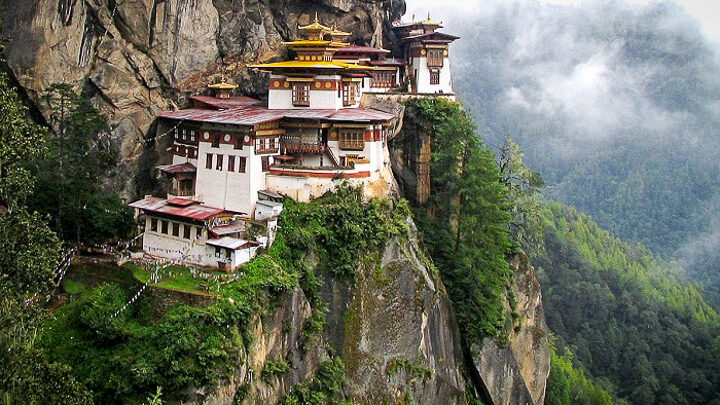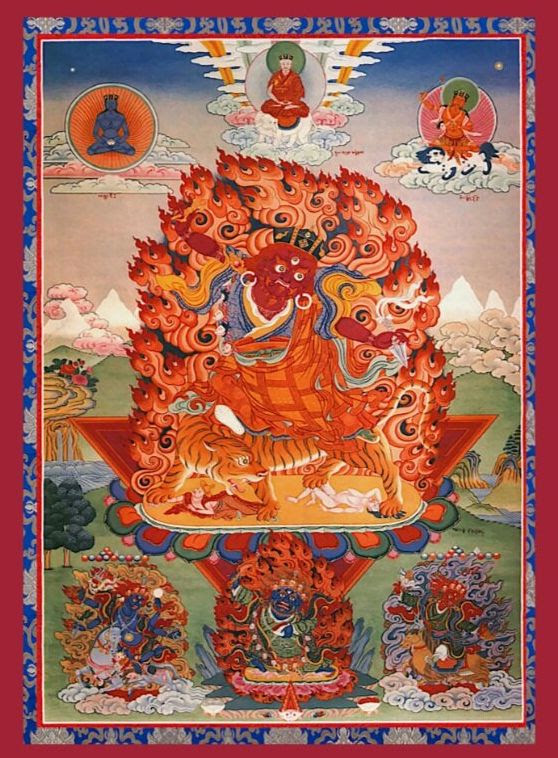
[Update! (March 25, 2025) Shambhala Publications has published these recordings in a new book by Chögyam Trungpa: The Sadhana of Mahamudra. Read the article below to learn more about the origins of the iconic sadhana and the historical context of the original 1975 teachings.]
Breaking Through in the Cave at Taktsang:
The Birth of The Sadhana of Mahamudra
Click here to jump to talk playlist and clip
When Chögyam Trungpa Rinpoche fled his homeland of Kham in eastern Tibet in 1959 ahead of an invading army, he was not simply emigrating from one country to another. He was leaving one cosmos and entering another. The world he knew was only intermittently penetrated by the ways and means of modern life. Travel for Trungpa Rinpoche was on foot or horseback. Heat and cooking were provided by an open fire. Life was simple, rugged, medieval even, a term he would later use as a badge of virtue. He was also completely engulfed in a system of Buddhism—imported from India and refined in the remote mountains and valleys of Tibet through ups and downs over the course of thirteen centuries—that was intended to result in enlightenment in one lifetime. He knew only one way of life and one mission in life: dharma.
The world he came into, first in India, then in Great Britain, and ultimately in North America, was alien to begin with, but was also going through massive cultural upheavals as a new and very big generation began to rebel against the value systems they were being asked to take up in the midst of the Cold War and a very hot war in Vietnam. These chaotic times created an opening for Trungpa Rinpoche to bring what he was trained to offer to the world to an entirely new group of people. Before he could do that, though, he had to make some breakthroughs of his own. In England, in his monk’s robes he felt as though he was regarded as a quaint artifact of a distant, exotic culture, like something to be displayed in the British Museum, a subject for a comparative religion discussion over tea. He had begun to connect with a handful of dedicated students in his new center in Scotland who were willing to dive in headfirst, but somehow the immense power of the dharma that had been deeply entrained in him was not fully coming across.

In the midst of the push and pull between his training and tradition and the landscape he was facing, he made a fateful trip to Bhutan, in 1968, at the invitation of the Queen. The visit culminated in a retreat in the cave at Taktsang (Tiger’s Nest), the cliffside hermitage where Padmasambhava—who was instrumental in bringing the dharma to Tibet—meditated and manifested in the form of wrathful compassion known as Dorje Trollo. It was in this cave that Trungpa Rinpoche’s sudden breakthrough occurred—it became clear that the principal obstacle was materialism, especially “spiritual materialism”: turning the path of dharma into a means to enhance and adorn ego rather than undermine it. The practice of the Sadhana of Mahamudra emerged from that cave and would ever after be a means for students to proclaim the power of cutting through spiritual materialism by rousing the energy of fierce compassion embodied by Dorje Trollo combined with the exemplary devotion of the Kagyu gurus, represented by the line of the Karmapas.

Less than two years after his retreat in Bhutan, Trungpa Rinpoche arrived in the US, in 1970. As his teaching spread, before long there were centers in most major cities and residential practice centers in both the eastern and western United States. As students gathered in these places, they would show up for sitting meditation practice after work one day only to be introduced to what was simply called “the Sadhana,” a long practice of chanting, meditation, and mantra recitation filled with potent imagery and deep feeling. It was practiced in the early evening every full and new moon. It left deep impressions, and gave rise to many questions, not the least of which was, “What exactly is crazy wisdom?”
By 1975, it seems, enough people had practiced the Sadhana that the time had come to address these questions and explore the deeper meaning of the profound and provocative language in the practice, resulting in a seminar in September at Karmê Chöling, in Vermont, The Embodiment of All the Siddhas, followed by one in November at Karma Dzong, in Boulder, Colorado, simply called Sadhana of Mahamudra. These talks, ten in total, are so rich in detail and feeling that they have served as the definitive commentary on the practice ever since. Not only that, they introduce us to what genuine devotion means, what it means to “give the giver” (offering everything, including most especially oneself), the interplay between emotion and insight and between mahamudra and maha ati, and the central question of which comes first, the wisdom or the crazy.
In each of the two seminars you are about to hear and see, Trungpa Rinpoche tells the very intimate story of how the Sadhana of Mahamudra came into being and speaks from his heart to share the very essence of what his teachers passed on to him, which he in turn continues to pass on to us, even to this day. These talks are not mere historical artifacts. Just as the Sadhana of Mahamudra itself jumps to life straight off the page, emerging in nowness, so too these talks jump straight off the screen and from Trungpa Rinpoche’s heart into your own.
The Sadhana of Mahamudra Playlist
- Community Talk: Introduction to the Sadhana of Mahamudra (Audio. Boulder, CO, 1975)
Embodiment of All the Siddhas (Audio. Karmê Chöling, VT, 1975)
- Talk 1: Historical Commentary
- Talk 2: Devotion and Crazy Wisdom
- Talk 3: The Mandala of the Siddhas
- Talk 4: Joining Insight and Tradition in the Rime Tradition
- Full seminar Playlist
Sadhana of Mahamudra (video. Boulder, Co, 1975)
- Talk 1: The Guru Principle
- Talk 2: Crazy Wisdom
- Talk 3: The Charnel Ground
- Talk 4: The Crazy Wisdom Body of All the Buddhas: Devotion and Blessings
- Talk 5: Surrendering
- Talk 6: Historical Commentary: Part Two
- Full seminar Playlist
Additional Resources:
Shambhala Publications
- The Sadhana of Mahamudra: Teachings on Devotion and Crazy Wisdom by Chögyam Trungpa: A newly-published book which includes the full Sadhana of Mahamudra text, both seminars, and rich supplementary material.
Nalanda Translation committee
THE CHRONICLES OF CHöGYAM TRUNGPA RINPOCHE
- Video: Larry Mermelstein and Barry Boyce on the Sadhana of Mahamudra
- Video: Kunga Dawa on Chögyam Trungpa and Sadhana of Mahamudra
- Video: Journey to Taktsang
- Article: On the Sadhana of Mahamudra (by Carolyn Rose Gimian)
Ocean Online Practice
Ocean online Recorded Courses
- Wisdom Gone Crazy, Part One (with Barry Boyce and Derek Kolleeny)
- Wisdom Gone Crazy, Part Two (with Barry Boyce and Derek Kolleeny)